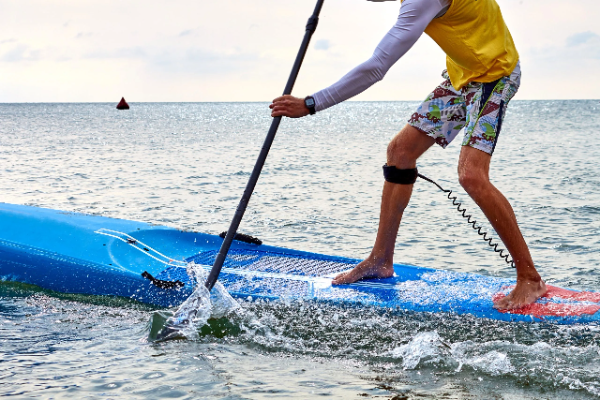Paddle boarding, also known as stand-up paddleboarding (SUP), is a popular water sport. It involves standing on a board and using a paddle to move through the water. It’s a great full-body workout and a fun way to explore various water bodies.
History of Paddle Boarding
Paddle boarding has its roots in ancient Polynesian culture. Early forms of the sport were practiced by native Hawaiians. Modern paddle boarding gained popularity in the 2000s, thanks to surf legends like Laird Hamilton.
Benefits of Paddle Boarding
Paddle boarding offers numerous benefits:
- Physical fitness: It provides a full-body workout.
- Mental health: Being on the water is calming and helps reduce stress.
- Accessibility: It can be enjoyed by people of all ages and fitness levels.
- Exploration: It allows you to explore lakes, rivers, and oceans.
Getting Started with Paddle Boarding
Choosing the Right Equipment
Board: Selecting the right board is crucial. There are different types of boards for various activities:
- All-around boards: Good for beginners and versatile for various conditions.
- Touring boards: Designed for long distances and smooth gliding.
- Surfing boards: Shorter and more maneuverable for waves.
- Racing boards: Long and narrow for speed.
Paddle: The paddle should be the correct length. A general rule is to have it 6-10 inches above your head.
Leash: The leash keeps the board attached to you, preventing it from drifting away if you fall.
Personal Flotation Device (PFD): Safety first! A PFD is essential, especially in open water.
Basic Techniques
Mounting the Board
- Start in shallow water: Place the board in knee-deep water.
- Hold the board: Keep the board stable with one hand.
- Climb on: Kneel in the center of the board, then stand up one foot at a time.
Paddle Stroke
- Basic stroke: Insert the paddle into the water in front of you. Pull it back alongside the board.
- Switch sides: To go straight, alternate strokes on each side.
Balancing
- Stand centered: Keep your feet parallel and centered on the board.
- Bend your knees: This helps absorb any motion from waves.
- Look ahead: Focus on the horizon to maintain balance.
Safety Tips
- Wear a PFD: Always wear a personal flotation device.
- Check weather conditions: Avoid going out in bad weather.
- Know your limits: Don’t paddle too far from shore if you’re a beginner.
Intermediate Paddle Boarding Skills
Turning Techniques
Sweep Stroke
- Wide arc: To turn left, paddle on the right side in a wide arc.
- Lean: Lean slightly in the direction you want to turn.
Cross-Bow Stroke
- Cross the paddle: Move the paddle across the nose of the board to the opposite side.
- Pull: Pull the paddle towards you to turn quickly.
Advanced Strokes
Forward Stroke Efficiency
- Reach forward: Extend the paddle as far forward as possible.
- Engage core muscles: Use your core for power, not just your arms.
- Exit smoothly: Lift the paddle out of the water when it reaches your feet.
Backward Stroke
- Reverse motion: Insert the paddle near your feet and push it towards the nose.
- Alternate sides: Use this stroke on both sides to reverse direction.
Dealing with Waves and Wind
- Small waves: Bend your knees and stay low for better stability.
- Large waves: Paddle over the crest of the wave and bend your knees.
- Wind: Paddle into the wind for more control and stability.
Advanced Paddle Boarding Techniques
Surfing on a Paddle Board
- Positioning: Stay in the surf zone and watch for incoming waves.
- Catching a wave: Paddle hard to match the speed of the wave.
- Ride the wave: Once caught, shift your weight back and ride the wave towards the shore.
Racing Tips
- Board choice: Use a racing board for better speed and efficiency.
- Paddle technique: Use a high cadence with shorter, powerful strokes.
- Training: Incorporate interval training and endurance paddles into your routine.
Yoga on a Paddle Board
- Calm water: Choose a calm and stable water surface.
- Balance poses: Start with basic poses like Warrior I and II.
- Breath control: Focus on your breathing to maintain balance and focus.
Paddle Boarding Etiquette
Respect Nature and Wildlife
- Stay clear: Avoid disturbing wildlife and natural habitats.
- Leave no trace: Clean up after yourself and don’t litter.
Respect Other Water Users
- Right of way: Yield to swimmers, surfers, and other paddle boarders.
- Communicate: Use hand signals or verbal communication to indicate your intentions.
See Also: Mastering the Waves: A Beginner’s Guide to Jet Skiing
Paddle Boarding Adventures
Exploring Different Water Bodies
- Lakes: Calm and perfect for beginners.
- Rivers: Offer a mix of calm and challenging conditions.
- Oceans: Great for surfing and long-distance paddling.
Planning a Paddle Boarding Trip
- Research: Know the area and conditions of the water body.
- Pack essentials: Bring water, snacks, a first aid kit, and safety gear.
- Tell someone: Inform a friend or family member about your plans.
Common Paddle Boarding Mistakes and How to Avoid Them
Incorrect Stance
- Problem: Standing too far forward or backward.
- Solution: Keep feet centered and shoulder-width apart.
Paddle Too Short or Too Long
- Problem: Inefficient paddling and poor control.
- Solution: Adjust the paddle to the correct length.
Ignoring Safety Gear
- Problem: Increased risk of injury or drowning.
- Solution: Always wear a PFD and use a leash.
Overexertion
- Problem: Fatigue and muscle strain.
- Solution: Pace yourself and take breaks as needed.
Conclusion
Paddle boarding is a fantastic way to enjoy the water, stay fit, and explore nature. By following these tips and techniques, you can paddle board like a pro. Remember to always prioritize safety, respect nature, and practice regularly to improve your skills.


